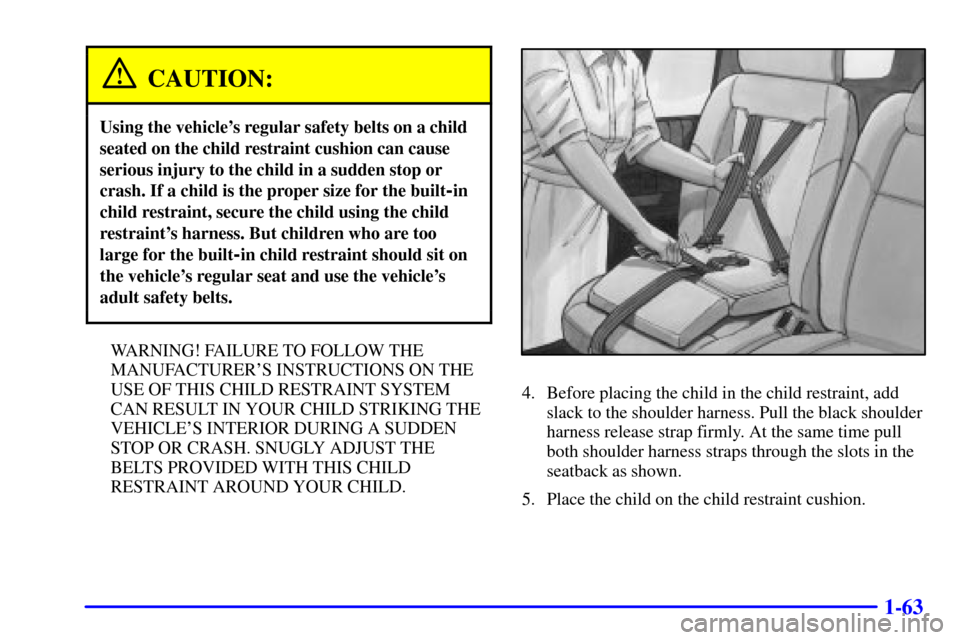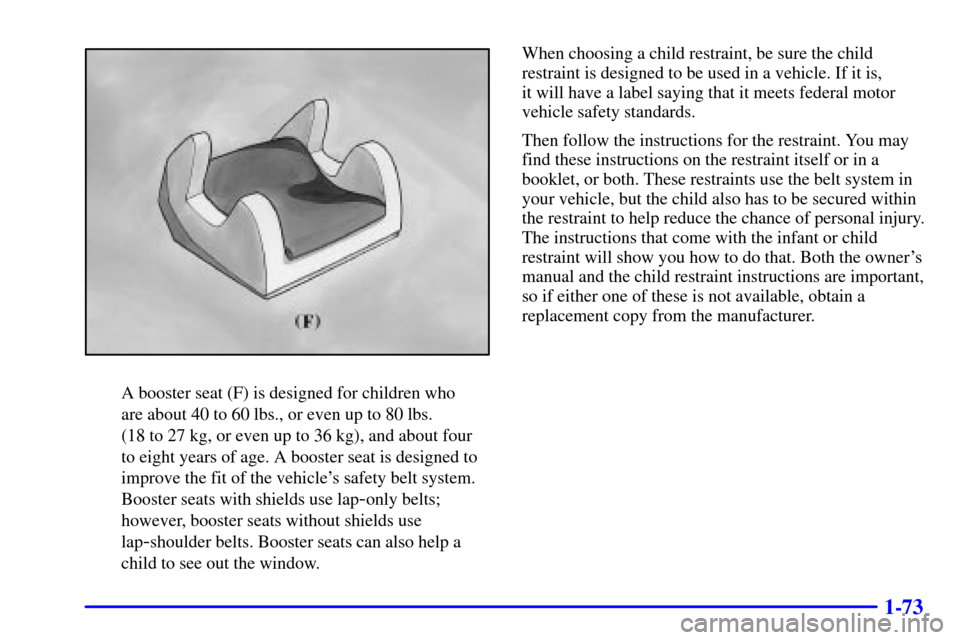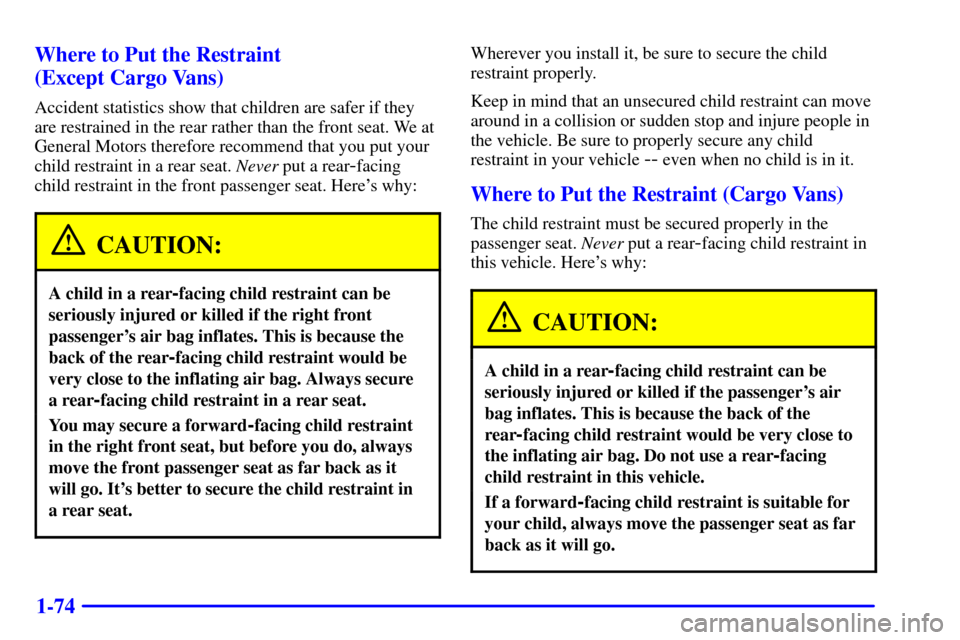Page 73 of 429
1-61 Securing a Child in the Built-In
Child Restraint
1. Raise the head restraint until the lower edge of the
head restraint is even with the top of the seatback.
2. Rotate the head restraint rearward until it touches the
top of the seatback. Make sure there is no gap
between the lower edge of the head restraint and the
top of the seatback.
Page 74 of 429
1-62
3. Lower the child restraint cushion.You'll be using the child restraint's harness (A)
to secure your child. Don't use the vehicle's
safety belts.
Page 75 of 429

1-63
CAUTION:
Using the vehicle's regular safety belts on a child
seated on the child restraint cushion can cause
serious injury to the child in a sudden stop or
crash. If a child is the proper size for the built
-in
child restraint, secure the child using the child
restraint's harness. But children who are too
large for the built
-in child restraint should sit on
the vehicle's regular seat and use the vehicle's
adult safety belts.
WARNING! FAILURE TO FOLLOW THE
MANUFACTURER'S INSTRUCTIONS ON THE
USE OF THIS CHILD RESTRAINT SYSTEM
CAN RESULT IN YOUR CHILD STRIKING THE
VEHICLE'S INTERIOR DURING A SUDDEN
STOP OR CRASH. SNUGLY ADJUST THE
BELTS PROVIDED WITH THIS CHILD
RESTRAINT AROUND YOUR CHILD.
4. Before placing the child in the child restraint, add
slack to the shoulder harness. Pull the black shoulder
harness release strap firmly. At the same time pull
both shoulder harness straps through the slots in the
seatback as shown.
5. Place the child on the child restraint cushion.
Page 76 of 429
1-64
6. Select only one side of the harness. Place the harness
over the child's shoulder.
7. Push the latch plate (B) into the buckle until it clicks.
Be sure the buckle is free of any foreign objects that
may prevent you from securing the latch plates.
If you can't secure a latch plate, see your dealer for
service before using the child restraint.8. Place the other side of the harness over the
child's shoulder.
9. Push the latch plate into the buckle until it clicks.
10. Pull up on both latch plates to make sure they
are secure.
Page 81 of 429
1-69
4. Then press the leg rest firmly into the seatback, and
secure it by pressing the upper corners against the
fastener strips on the seatback.5. Rotate the head restraint forward and push it all the
way down.
Just like the other restraint systems in your vehicle, your
built
-in child restraint needs to be periodically checked
and may need to have parts replaced after a crash. See
ªChecking Your Restraint Systemsº and ªReplacing Seat
and Restraint System Parts After a Crashº in the Index.
Page 83 of 429
1-71
A rear-facing infant restraint (B) positions an infant
to face the rear of the vehicle. Rear
-facing infant
restraints are designed for infants of up to about
20 lbs. (9 kg) and about one year of age. This type
of restraint faces the rear so that the infant's head,
neck and body can have the support they need
in a frontal crash. Some infant seats come in
two parts
-- the base stays secured in the vehicle
and the seat part is removable.
Page 85 of 429

1-73
A booster seat (F) is designed for children who
are about 40 to 60 lbs., or even up to 80 lbs.
(18 to 27 kg, or even up to 36 kg), and about four
to eight years of age. A booster seat is designed to
improve the fit of the vehicle's safety belt system.
Booster seats with shields use lap
-only belts;
however, booster seats without shields use
lap
-shoulder belts. Booster seats can also help a
child to see out the window.When choosing a child restraint, be sure the child
restraint is designed to be used in a vehicle. If it is,
it will have a label saying that it meets federal motor
vehicle safety standards.
Then follow the instructions for the restraint. You may
find these instructions on the restraint itself or in a
booklet, or both. These restraints use the belt system in
your vehicle, but the child also has to be secured within
the restraint to help reduce the chance of personal injury.
The instructions that come with the infant or child
restraint will show you how to do that. Both the owner's
manual and the child restraint instructions are important,
so if either one of these is not available, obtain a
replacement copy from the manufacturer.
Page 86 of 429

1-74 Where to Put the Restraint
(Except Cargo Vans)
Accident statistics show that children are safer if they
are restrained in the rear rather than the front seat. We at
General Motors therefore recommend that you put your
child restraint in a rear seat. Never put a rear
-facing
child restraint in the front passenger seat. Here's why:
CAUTION:
A child in a rear-facing child restraint can be
seriously injured or killed if the right front
passenger's air bag inflates. This is because the
back of the rear
-facing child restraint would be
very close to the inflating air bag. Always secure
a rear
-facing child restraint in a rear seat.
You may secure a forward-facing child restraint
in the right front seat, but before you do, always
move the front passenger seat as far back as it
will go. It's better to secure the child restraint in
a rear seat.
Wherever you install it, be sure to secure the child
restraint properly.
Keep in mind that an unsecured child restraint can move
around in a collision or sudden stop and injure people in
the vehicle. Be sure to properly secure any child
restraint in your vehicle
-- even when no child is in it.
Where to Put the Restraint (Cargo Vans)
The child restraint must be secured properly in the
passenger seat. Never put a rear
-facing child restraint in
this vehicle. Here's why:
CAUTION:
A child in a rear-facing child restraint can be
seriously injured or killed if the passenger's air
bag inflates. This is because the back of the
rear
-facing child restraint would be very close to
the inflating air bag. Do not use a rear
-facing
child restraint in this vehicle.
If a forward-facing child restraint is suitable for
your child, always move the passenger seat as far
back as it will go.